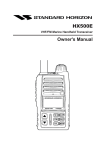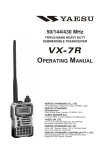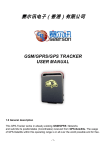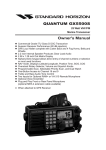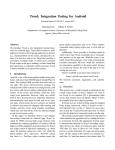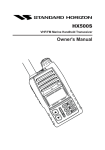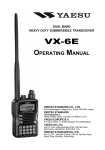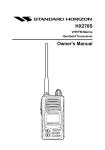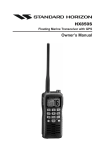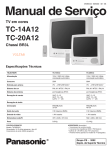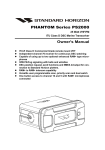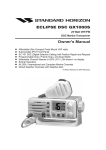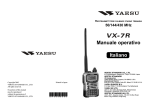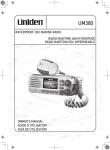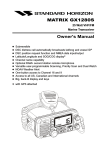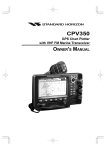Download HX471S Owner`s Manual
Transcript
HX471S Submersible Multi Band Marine Portable Owner's Manual HX471S TABLE OF CONTENTS RF EXPOSURE SAFETY STATEMENT ...................................................................................... 2 FCC AND CANADA RADIO LICENSE INFORMATION .............................................................. 3 FCC NOTICE ............................................................................................................................... 5 1. GENERAL INFORMATION ...................................................................................................... 6 1.1 INTRODUCTION .............................................................................................................. 6 2. ACCESSORIES ....................................................................................................................... 7 2.1 PACKING LIST .................................................................................................................. 7 2.2 OPTIONS .......................................................................................................................... 7 3. ABOUT THIS RADIO ............................................................................................................... 8 3.1 ABOUT THE VHF MARINE BAND ..................................................................................... 8 3.2 ABOUT FRS (Family Radio Service) .................................................................................. 8 3.3 ABOUT RECEIVE ONLY CHANNELS AND FREQUENCIES .......................................... 10 4. GETTING STARTED .............................................................................................................. 12 4.1 BATTERES AND CHARGERS ........................................................................................ 12 4.2 CONNECTING A GPS TO THE CD-25 ............................................................................ 17 5. CONTROLS AND SWITCHES ............................................................................................... 18 6. BASIC OPERATION .............................................................................................................. 22 6.1 INITIAL SETUP ................................................................................................................ 22 6.2 RECEPTION .................................................................................................................... 23 6.3 TRANSMISSION .............................................................................................................. 24 6.4 NOAA WEATHER CHANNELS ....................................................................................... 25 6.5 PRESET CHANNELS (P0 ~ P9) ...................................................................................... 26 6.6 ENABLING S.O.S STROBE OPERATION ....................................................................... 27 7. ADVANCED OPERATION ON THE MARINE BAND ............................................................. 28 7.1 USA, CANADA, AND INTERNATIONAL CHANNELS ..................................................... 28 7.2 MEMORY SCAN .............................................................................................................. 28 7.3 PRIORITY SCAN ............................................................................................................. 29 7.4 DUAL WATCH ................................................................................................................. 30 7.5 EMERGENCY CHANNEL 16 ........................................................................................... 30 7.6 CHANNEL 9 ..................................................................................................................... 30 7.7 OPERATING ON USA or CANADIAN 13, OR USA CHANNEL 67 .................................. 30 7.8 OPERATING ON USA CHANNEL 67 .............................................................................. 31 7.9 DIGITAL SELECTIVE CALLING ...................................................................................... 31 7.10 SIMPLEX/DUPLEX CHANEL USE ................................................................................ 32 8. CTCSS OPERATION ON THE FRS BAND ........................................................................... 33 8.1 CTCSS CODE OPERATION ........................................................................................... 33 9. BAROMETER AND SCRAMBLER OPERATION .................................................................. 34 9.1 BAROMETRIC PRESSURE METER ............................................................................... 34 9.2 VOICE SCRAMBLER UNIT ............................................................................................. 34 10. OPERATING PRACTICE ..................................................................................................... 35 10.1 EMERGENCY (CHANNEL 16 USE) .............................................................................. 35 10.2 CALLING ANOTHER VESSEL (CHANNEL 16 OR 9) .................................................... 35 10.3 OPERATING ON CHANNEL 13 AND 67 ....................................................................... 36 10.4 PROHIBITED COMMUNICATIONS ............................................................................... 37 10.5 NOAA WEATHER ALERT TESTING ............................................................................. 37 11. RESETTING THE TRANSCEIVER’S MICROPROCESSOR .............................................. 38 12. CLONING ............................................................................................................................. 39 13. MENU (“SET”) MODE ......................................................................................................... 40 14. MAINTENANCE ................................................................................................................... 44 14.1 GENERAL ...................................................................................................................... 44 14.2 REPLACEMENT PARTS ............................................................................................... 44 14.3 TROUBLESHOOTING CHART ..................................................................................... 45 15. INSTALLATION OF OPTIONS ............................................................................................. 46 16.VHF MARINE CHANNEL ASSIGNMENT ............................................................................. 47 17. WARRANTY ......................................................................................................................... 53 18. SPECIFICATIONS ............................................................................................................... 56 HX471S Congratulations on your purchase of the HX471S! Whether this is your first portable marine VHF transceiver, or if you have other STANDARD HORIZON equipment, the STANDARD HORIZON organization is committed to ensuring your enjoyment of this high performance transceiver, which should provide you with many years of satisfying communications even in the harshest of environments. STANDARD HORIZON technical support personnel stands behind every product sold, and we invite you to contact us should you require technical advice or assistance. We appreciate your purchase of the HX471S, and encourage you to read this manual thoroughly, so as to learn and fully understand the capabilities of the HX471S. WARNING This radio is capable of transmitting on VHF Marine and FRS. The FCC allows the use of VHF Marine band on water areas only. However the FCC does not allow the use of the VHF Marine band when on land. If persons use the VHF Marine Band on land and interfere with others communicating, the FCC will be notified and search for the interference. Responsible parties found to be transmitting on the VHF Marine Band on land could be fined up to $10,000 for the first offense. FRS Band may be used on the land and water. The FCC does however prohibit the use in aircraft. HX471S Page 1 RF EXPOSURE SAFETY STATEMENT SAFETY INFORMATION Your wireless handheld portable transceiver contains a low power transmitter. When the Push-to-Talk (PTT) button is pushed, the transceiver sends out radio frequency (RF) signals. In August 1996, the Federal Communications Commission adopted RF exposure guidelines with safety levels for hand-held wireless devices. This device is authorized to operate at a duty factor not to exceed 50% (this corresponds to 50% transmission time and 50% reception time). WARNING: To maintain compliance with the FCC’s RF exposure guidelines, this transmitter and its antenna must maintain a separation distance of at least 1 inch (2.5 centimeters) from your face. Speak in a normal voice, with the antenna pointed up and away from the face at the required separation distance. If you use a headset accessory for this radio, with the radio worn on your body, use only the Vertex Standard belt clip for this transceiver, and ensure that the antenna is at least 1 inch (2.5 centimeters) from your body when transmitting. Use only the supplied antenna. Unauthorized antennas, modifications, or attachments could damage the transmitter, and may violate FCC regulations. NOTE This radio telephone complies with the requirements of RTCM Paper 56-95/SC101 Standards for digital selective calling (DSC) for Marine transceivers. Page 2 HX471S FCC AND CANADA RADIO LICENSE INFORMATION Standard Horizon radios comply with the Federal Communication Commission (FCC) and Industry-Canada requirements that regulate the Maritime Radio Service. MARITIME STATION LICENSE An FCC ship station license is no longer required for any vessel traveling in U.S. waters which uses a VHF marine radio, RADAR or EPIRB, and which is not required to carry radio equipment. However, any vessel required to carry a marine radio on an international voyage, carrying a HF single side band radiotelephone or marine satellite terminal. FCC license forms, including applications for ship (506) and land station licenses can be downloaded via the Internet at www.fcc.gov/forms. To obtain a form from the FCC, call (888) 225-5322. MARINE RADIO CALL SIGN Currently the FCC does not require recreational boaters to have a Ship Radio Station License. The USCG recommends the boats registration number and the state to be used. CANADIAN SHIP STATION LICENSING You may need a license when traveling in Canada. If you do need a license contact their nearest field office or regional office or write: Industry Canada Radio Regulatory Branch Attn: DOSP 300 Slater Street Ottawa, Ontario Canada, KIA 0C8 FCC/INDUSTRY CANADA INFORMATON The following data pertaining to the transceiver is necessary to fill out the license application. FCC Type Accepted: ........................................................................ Part 80 Output Power with FNB-80LI: ....... 1 W (Low), 2.5 W (Mid), and 5 W (High) Emission: ................................................................... 16K0G3E, 16K0G2B Frequency Range: ................................................. 156.025 to 163.275MHz FCC Type Number: ............................................................... K66HX470SA Industry Canada Type Approval: ....................................... 511B-HX470S V HX471S Page 3 FRS LICENSING No FCC license is required to use the FRS Frequencies. You are allowed to operate the HX471S on the FRS channels if you are not a representative of a foreign government, and if you cooperate in the selection and use of channels in order to reduce interference to others. There is no need to identify your transmissions with a call sign; however you must monitor the channel before transmitting to reduce interference with other stations. Page 4 HX471S FCC NOTICE Unauthorized changes or modifications to this equipment may void compliance with FCC Rules. Any change or modification must be approved in writing by STANDARD HORIZON, a Marine Division of VERTEX STANDARD. NOTICE This equipment has been tested and found to comply with the limits for a Class B digital device, pursuant to Part 15 of the FCC Rules. These limits are designed to provide reasonable protection against harmful interference in a residential installation. This equipment generates uses and can radiate radio frequency energy and, if not installed and used in accordance with the instructions, may cause harmful interference to radio communications. However, there is no guarantee that interference will not occur in a particular installation. If this equipment does cause harmful interference to radio or television reception, which can be determined by turning the equipment off and on, the user is encouraged to try to correct the interference by one or more of the following measures: r Increase the separation between the equipment and receiver. r Connect the equipment into an outlet on a circuit different from that to which the receiver is connected. r Consult the dealer or an experienced marine electronics technician for help. HX471S Page 5 1. GENERAL INFORMATION 1.1 INTRODUCTION The HX471S is a SUBMERSIBLE miniature 5-Watt portable two way Dual Band marine transceiver. The transceiver has all allocated USA, International, or Canadian channels. It has emergency channel 16 which can be immediately selected from any channel by pressing the [16/9] key. NOAA Weather channels can also be accessed immediately by pressing the [WX] key. In addition to these functions the HX471S can transmit a Digital Selective Distress Call with Latitude/Longitude when a GPS is connected to the CD-25 Cradle Charger. Besides VHF marine transceiver operation, the HX471S provides FRS (Family Radio Service) 460 MHz (0.5 Watts) transceiver operation, receive ONLY coverage of AM, FM broadcast bands, AM aircraft bands, and MURS. The HX471S includes the following features: Memory Scanning, Priority Scanning, NOAA Weather Alert, Battery Saver, easy-to-read large LCD display, EEPROM memory back-up, Battery Life displayed on LCD, and a transmit Time-Out Timer (TOT). In the marine band, the transmitter provides a maximum of 5 Watts output, and has the selection of 2.5 Watts and 1 Watt to assist the user in ensuring maximum battery life. The optional SU-1 Barometric Pressure Sensor Unit can be installed to provide readout of the current barometric pressure. Or (not simultaneously) The optional FVP-31 Voice Scrambler can be installed to permit secure voice communications with other Standard Horizon radios with the FVP-31 or CVS2500 scramblers installed. Page 6 HX471S 2. ACCESSORIES 2.1 PACKING LIST When the package containing the transceiver is first opened, please check it for the following contents: r r r r r r r r HX471S Transceiver FNB-80LI 1300 mAh Lithium Ion Battery Pack CD-25 Charger Cradle for HX471S NC-72B 120VAC Wall Charger for CD-25 E-DC-19 DC Cable with 12 V Cigarette Lighter Plug for CD-25 CLIP-14 Belt Clip with screw Lanyard Owner’s Manual 2.2 OPTIONS CMP460 Noise-canceling Waterproof Speaker/Microphone MH-57A4B Mini Speaker/Microphone VC-24 VOX Headset CT-32 Clone Cable SU-1 Barometric Pressure Sensor Unit FVP-31 Voice Scrambler FBA-23 Alkaline Battery Case FNB-80LI 1300mAh Lithium Ion Battery Pack E-DC-19 DC Cable with 12 V Cigarette Lighter Plug NC-72C 230-240 VAC Wall Charger for the FNB-80LI E-DC-6 DC Cable; plug and wire only Note: Before operating the HX471S for the first time, it is recommended that the battery be charged. Please see section 4.1.4 “USING THE CD-25 CHARGER CRADLE” for details. HX471S Page 7 3. ABOUT THIS RADIO 3.1 ABOUT THE VHF MARINE BAND WARNING: The radio frequencies used in the VHF marine band lie between 156 and 158 MHz with NOAA Weather stations available between 161 and 163 MHz. The marine VHF band provides communications over distances that are essentially “line of sight” Actual transmission range depends much more on antenna type, gain and height than on the power output of the transmitter. On a fixed mount 25W radio transmission expected distances can be greater than 15 miles, for a portable 5W radio transmission the expected distance can be greater than 5 miles in “line of sight”. The user of a Marine VHF radio is subject to severe fines if the radio is used on land. The reasoning for this is you may be near an inland waterway, or propagation anomalies may cause your transmission to be heard in a waterway. If this occurs, depending upon the marine VHF channel on which you are transmitting, you could interfere with a search and rescue case, or contribute to a collision between passing ships. For VHF Marine channel assignments refer to page 47 section 16. 3.2 ABOUT FRS (FAMILY RADIO SERVICE) FRS is a private, two-way, very short-distance voice communications service for facilitating family and group activities Areas of Operation You may operate your FRS radio in the United States and certain locations specified by the FCC [95.192]. If you want to use FRS aboard a vessel or aircraft owned or operated by a U.S. citizen or company, you will need permission from the captain of the vessel. You must share the channel with other users [95.191(b)]. There is no meaningful way to share the channel with others unless you listen before transmitting and wait until the channel is available before you transmit. To listen 1 2 3 4 462.5625 MHz 462.5875 MHz 462.6125 MHz 462.6375 MHz Page 8 5 6 7 8 FRS CHANNEL CHART 462.6625 MHz 9 467.5875 MHz 462.6875 MHz 10 467.6125 MHz 462.7125 MHz 11 467.6375 MHz 467.5625 MHz 12 467.6625 MHz 13 14 - 467.6875 MHz 467.7125 MHz ----- HX471S to the channel, you must disable any tone squelch. Also, you must at all times and on all FRS channels, give priority to emergency messages [95.193(d)]. Refer to page 23 (reception), 24 (transmitting), and 33 (CTCSS) for operation. HX471S Page 9 3.3 ABOUT RECEIVE ONLY CHANNELS and FREQUENCIES AM/FM Broadcast Bands The AM/FM bands contained within the HX471S are the same channels you use every day to listen to music, news and commentary with your car or home stereo. The AM broadcast band currently extends from 530 to 1700 kHz. Channels are spaced in even 10 kHz increments; i.e.: 530, 540, 550, ... , 1600 kHz in the United States and Canada. Elsewhere, channels are spaced in 9 kHz increments, i.e.: 531, 540, 549, etc. The FM broadcast band in the United States extends from 88 to 108 MHz. Channels are assigned at 200 kHz increments; i.e.: 88.1, 88.3, 88.5, ... , 107.9. The channels from 88.1 to 91.9 are reserved for noncommercial educational stations. Outside the United States and Canada, the boundaries and channel spacing vary. In Japan, the band starts at 76 MHz. In Western Europe, the band generally runs from 88-108 MHz, but channels can be irregularly spaced, i.e.: 101.25 MHz. AIR (Aircraft) Bands The AM VHF aeronautical communications band lies between 108.000 MHz and 136.975 MHz. This frequency spectrum can be divided into a lower and upper range. The lower range between 108.000 MHz and 118.000 MHz is primarily used for navigational aids such as the ILS Instrument Landing Systems, DME - Distance Measuring Equipment, and VOR’s - Very High Frequency Omni Range. The lower range offers very little in the way of voice communications, it does however provide someone with a working knowledge of Morse code the opportunity to identify various beacons. The upper range of the aeronautical band 118.000 MHz to 136.975 MHz is where the majority of voice communications can be monitored. Communications in the VHF band are transmitted in AM mode and most if not all compatible receivers automatically default to this mode. Frequencies within the aeronautical range are spaced in increments of 25 kHz, as such you will find transmissions at 118.000, 118.025, 118.050 MHz etc. The frequency(s) you monitor will determine the nature of traffic you will hear. As previously mentioned frequencies in the lower range of the aeroPage 10 HX471S nautical band are mostly occupied by navigational equipment and transmit non voice signals in Morse code. If you select a frequency in the upper range the air is suddenly filled with conversations between pilots and air traffic controllers, pilots and their company dispatchers, flight service stations, and ATIS broadcasts. Frequencies within the aeronautical band are designated according to their usage. Refer to the page 23 for operation. AIR (Aircraft) BAND FREQUENCY CHART Frequency Range Communications Usage 108.000 - 117.975 MHz Navigational Aids 118.000 - 121.400 MHz Control Towers 121.500 MHz Int’l Distress Frequency 121.600 - 122.900 MHz Ground & Apron Control 122.700 - 123.900 MHz UNICOM Frequencies 123.450 MHz Air to Air / Pilot chit chat 124.000 - 128.800 MHz Arrivals & Departures 128.825 - 132.000 MHz Company Operations 132.000 - 135.975 MHz Area Control Centre (Enroute) 136.000 - 136.975 MHz Shared ATC/Company Ops & DataLink MURS (MULTIPLE-USE RADIO SERVICE) Bands MURS is a private short distance voice communication service for personal or business activitys of the general public in the U.S. MURS channels can be received on this radio. The frequency and channel number is as follows. MURS CHANNEL CHART 1 151.820 MHz 2 151.880 MHz 3 151.940 MHz 4 154.570 MHz 5 154.600 MHz HX471S Page 11 4. GETTING STARTED If the radio has never been used, or its charge is depleted, it may be charged by connecting the CD-25 Charger Cradle with the NC-72 battery charger, as shown in the illustration. If 12V DC power is available, the optional E-DC-19 DC Cable with 12 V Cigarette Lighter Plug or the optional E-DC-6 DC Cable may be used for charging the battery. The NC-72, E-DC-19 and E-DC-6 will charge a completely discharged FNB-80LI battery pack in about 3 hours. 4.1 BATTERIES AND CHARGERS The FNB-80LI is a high performance Lithium-Ion battery providing high capacity in a very compact package. CAUTION To avoid risk of explosion and injury, FNB-80LI battery pack should only be removed, charged or recharged in non-hazardous environments. 4.1.1 BATTERY SAFETY Battery packs for your transceiver contain Lithium-Ion batteries. This type of battery stores a charge powerful enough to be dangerous if misused or abused, especially when removed from the transceiver. Please observe the following precautions: DO NOT SHORT BATTERY PACK TERMINALS: Shorting the terminals that power the transceiver can cause sparks, severe overheating, burns, and battery cell damage. If the short is of sufficient duration, it is possible to melt battery components. Do not place a loose battery pack on or near metal surfaces or objects such as paper clips, keys, tools, etc. When the battery pack is installed on the transceiver, the terminals that transfer current to the transceiver are not exposed. The terminals that are exposed on the battery pack when it is mounted on the transceiver are charging terminals only and do not constitute a hazard. DO NOT INCINERATE: Do not dispose of any battery in a fire or incinerator. The heat of fire may cause battery cells to explode and/or release dangerous gases. Page 12 HX471S Battery Maintenance For safe and proper battery use, please observe the following: r Battery packs should be charged only in non-hazardous environments; r Use only STANDARD HORIZON-approved batteries; r Use only a STANDARD HORIZON, (a Marine Division of VERTEX STANDARD) approved charger. The use of any other charger may cause permanent damage to the battery. r Follow charging instructions provided with the chargers. r Keep the battery contacts clean. Battery Storage Store batteries in a cool place to maximize storage life. Since batteries are subject to self-discharge, avoid high storage temperatures that cause large self-discharge rates. After extended storage, a full recharge is recommended. Battery Recycling DO NOT PLACE USED BATTERIES IN YOUR REGULAR TRASH! LITHIUM-ION BATTERIES MUST BE COLLECTED, RECYCLED OR DISPOSED OF IN AN ENVIRONMENTALLY SOUND MANNER. The incineration, land filling or mixing of nickel-cadmium batteries with the municipal solid waste stream is PROHIBITED BY LAW in most areas. Return batteries to an approved lithium-ion battery recycler. This may be where you purchased the battery. Contact your local waste management officials for other information regarding the environmentally sound collection, recycling and disposal of lithium-ion batteries. HX471S Page 13 4.1.2 BATTERY CHARGING If the radio has never been used, or its charge is depleted, it may be charged by connecting the CD-25 Charger Cradle with the NC-72 battery charger, as shown in the illustration. If 12V DC power is available, the optional E-DC-19 DC Cable with 12 V Cigarette Lighter Plug or the optional E-DC-6 DC Cable may be used for charging the battery. The NC-72, E-DC-19 and E-DC-6 will charge a completely discharged FNB-80LI battery pack in about 3 hours. NC-72, E-DC-6, or E-DC-19 4.1.3 BATTERY INSTALLATION/REMOVAL 1. Turn the transceiver off. 2. To install, insert the battery pack into the battery compartment on the back of the transceiver, then close the Battery Pack Latch until it locks in place with a “click.” 3. To remove, open the Battery Pack Latch on the bottom of the transceiver, then slide the battery downward and out from the transceiver. Page 14 HX471S 4.1.4 USING THE CD-25 CHARGER CRADLE 1. Turn the transceiver off. 2. Insert the DC plug from the NC-72 into the DC jack on the CD-25 rear panel, then plug the NC-72 into the AC line outlet. 3. Insert the HX471S (with the battery pack) into the CD-25; the antenna should be at the left side when viewing the charger from the front. 4. If the HX471S is inserted correctly, the Red “CHARGING” indicator will glow. A fully-discharged pack will be charged completely in approximately 3 hours. 5. The Red “CHARGING” indicator will blink when charging is nearing completion. 6. When charging is completed, the Red “CHARGING” indicator will disappear, and the Green “FULL” indicator will glow. Disconnect the pack from the CD-25, and unplug the NC-72 from the AC line outlet. 4.1.5 MOUNTING THE CD-25 ON THE VESSEL The CD-25 is designed to be surface or wall mounted on a vessel which can be connected to the charger and a GPS that supplies NMEA data for DSC Distress transmissions. If mounting on a vessel the CD-25 must be mounted in a location on the vessel that is directly shielded from rain or splashes of water. After the location is found mount the CD-25 using the supplied mounting screws. CD-25 Desktop Mount HX471S CD-25 Wall Mount Page 15 When using the HX471S/CD-25 on the vessel, be sure to secure the mounting band on the CD-25 so that it secures the HX471S so it will not fall out due to rough seas. See the illustration below. Page 16 HX471S 4.2 CONNECTING A GPS TO THE CD-25 The CD-25 is supplied with a cable that is designed to be connected to any GPS that has an NMEA Output with the GLL, GGA, GNS, or RMC sentences. Check with the owner’s manual of the GPS to confirm this information. The NMEA wires are located underneath CD-25. Remove the round white plate from the CD-25 to expose the NMEA wires for connections to a GPS. Blue – NMEA Input (Connects to NMEA Out of GPS) Green – NMEA Negative (Connects to NMEA Negative or battery Ground of GPS) If you have further inquires, please feel free to contact us at: Phone: (800) 767-2450 Fax: (714) 527-9031 Web site: standardhorizon.com Email: [email protected] Manufacturer/Model Wires HX471S (CD-25) STANDARD HORIZON CP150, CP160 and CP-170C Green Green Brown Blue Furuno GP30, 36 White Blue Blue Green Furuno GP1650, 1850 Garmin Fixed Mounts Garmin Portables JRC GPS500 JRC 100 SERIES JRC 200 SERIES Lowrance Fixed Mount White Blue Black Green Blue Blue Black (GND) Green Brown Blue Black (GND) Green Yellow Blue Green Green Green Blue Black Green White Blue Black Green White Blue Black (GND) Green HX471S (CD-25) Manufacturer/Model Wires Lowrance Portable Orange Blue Black (GND) Green Magellan Fixed Mount Magellan Portable Northstar Raytheon 420 Raytheon 520 / 620 Raytheon RL SERIES Simrad Sitex Neptune, Nautilus Gray Blue Black (GND) Green Orange Blue Black (GND) Green Yellow Blue Black (GND) Green Yellow Blue Brown Green Blue Blue Brown Green White Blue Brown Green White Blue Brown Green Gray Blue Brown Green To connect to a GPS receiver, please use the above chart that will help you connect the wires between the CD-25 and the GPS. Insure that the wires are properly shielded from water. See the figure at the right for example of connection to STANDARD HORIZON GPS CHART PLOTTER. HX471S Page 17 5. CONTROLS AND SWITCHES NOTE This section defines each control of the transceiver. For detailed operating instructions, refer to section 6 “BASIC OPERATION.” Refer to illustrations for the location of the following controls, switches, and connections. Page 18 HX471S POWER SWITCH/VOLUME CONTROL Turns the transceiver on and off, and adjusts the volume. SQUELCH (SQL) CONTROL Sets the point at which random noise on the channel does not activate the audio circuits but a received signal does. This point is called the Squelch threshold. Further adjustment of the squelch control will degrade the reception of wanted transmissions. MIC/SP JACK The jack accepts the optional CMP460 Speaker/Microphone, MH-57A4B Mini Speaker/Microphone, or VC-24 VOX Headset. When this jack is used, the internal speaker is disabled. PUSH-TO-TALK (PTT) SWITCH When pushed activates the transmitter of the selected band. LAMP (KEY LOCK) KEY Press to turn the LCD and keypad backlighting on or off. Hold down this key to lock the keypad (except the PTT, LAMP, and [H/L] keys) so that they are not accidentally changed. The key lock symbol will appear on the LCD, to indicate that the functions are locked. Hold down until the key lock symbol disappears to unlock the radio. [BAND] KEY Press to select the VHF Marine, FRS , MURS , FM Broadcast, AM Broadcast, and AIR (aircraft) bands. [16/9] KEY Immediately recalls channel 16 from any marine channel or band location. Holding down this key recalls channel 9. [WX] KEY Immediately recalls the last-used NOAA Weather Channel from any channel location. Recalls the previously- selected working channel when the [WX] key is pressed again. Secondary use: When the [16/9] key is held and the [WX] key is pressed, the radio will change the marine channel between the USA, International, and Canadian channels. HX471S Page 19 [p(UP)] KEY Press to select a desired channel. Each press increases the channel number. When held down, the channels increase continuously. [q(DOWN)] KEY Press to select a desired channel. Each press decreases the channel number. When held down, the channels decrease continuously. NMEA TERMINAL Connect to GPS receiver that outputs NMEA sentences GLL, GGA, GNS, and RMC via the CD-25 Charger Cradle. Keep these terminals clean. [SCAN] KEY Starts scanning and priority scanning of programmed channels. When scanning, press and hold this key to turn on and off priority scan (P is shown on the left side of the display during Priority scanning). [PRESET] KEY Immediately recalls one of up to 10 user preset memories for each band (shown as P0-P9 on the LCD). Pressing this key repeatedly scrolls through the preset memory channels. [H/L] KEY On the Marine Band, changes the transmitter output power between High (5 Watts), Medium (2.5 Watts), and Low (1 Watt). Does not operate on “Low power only,” Marine “transmission inhibit,” or FRS channels. [DW] KEY Automatically scans between the priority channel and another selected channel (including FRS or a MURS channel). When receiving a signal on the selected channel the radio will dual watch to the priority channel. [MENU] KEY Select the Marine Band then press to select the Setup mode. This mode allows features and functions to be changed. Refer to section 13. MENU (“SET”) MODE for additional information. Page 20 HX471S [MEM] KEY Press this key to memorize the selected channel for scanning. When pressed a “MEM” icon will be shown on the LCD display indicating the channel has been saved to scan memory. The scan memory is only used with the Marine and WX channels. To delete the channel from scan memory, select the channel and press this key until “MEM” is removed from the display. BUSY/TX INDICATOR This indicator illuminates different colors depending on the band that is selected. The chart to the right shows BAND COLOR Blue the colors illuminated with the Squelch MARINE Green control fulluy counter clockwise or a sig- FRS MURS Yellow nal is received. This indicator glows red AM/FM/AIR/MURS Marine Blue during transmit. [DISTRESS] KEY When radio is programmed with a MMSI and this key is pressed once and pressed and held again for 3 seconds the radio will transmit a DSC Distress Call. To send the distress call, see section 7.9 “DIGITAL SELECTIVE CALLING.” HX471S Page 21 6. BASIC OPERATION 6.1 INITIAL SETUP 1. Install the belt clip on the transceiver according to the description in the box below, if desired. 2. Install the nylon carrying strap on the belt clip, if desired. 3. Install the battery pack on the transceiver (see section 4.1.3 “BATTERY INSTALLATION/REMOVAL”). NOTE: Water resistance of the transceiver is assured only when the battery pack is attached to the transceiver and MIC/SP rubber cap is installed in the MIC/SP jack. How to use the Quick Draw Belt Clip 1. Connect the hanger to the rear of the HX471S, with the notch pointing directly up, using the supplied screw (Figure 1). Use only the screw included with the clip to mount the clip to the back of the transceiver! 2. Clip the Quick Draw Belt Clip to your belt (Figure 2). 3. To install the HX471S into the Quick Draw Belt Clip, align the hanger with the Quick Draw Belt Clip and slide the HX471S into its slot until a click is heard. 4. To remove the HX471S from the Quick Draw Belt Clip, rotate the HX471S 180 degrees, then slide the transceiver out from the Quick Draw Belt Clip (Figure 3). ñ ò Figure 1 Page 22 Figure 2 Figure 3 HX471S 6.2 RECEPTION 1. Turn the POWER/VOLUME CONTROL knob clockwise to turn the transceiver on. 2. Turn the SQUELCH CONTROL knob fully counterclockwise. This state is known as “Squelch Off.” 3. Turn up the POWER/VOLUME CONTROL knob until the noise or audio from the speaker is at a comfortable level. 4. Select the desired operating band among the VHF Marine band, FRS band, MURS band, FM band, AM band, and AIR band by pressing the [BAND] key repetitively to switch between the bands. 5. Turn the squelch control fully to the left so audio is heard. 6. Press the [p] or [q] key to select a channel or frequency that has no signal being received (no one is transmitting on the channel) 7. Slowly turn the SQUELCH CONTROL knob clockwise and stop immediately after the noise disappears. This condition is known as the “Squelch Threshold.” If the knob is turned clockwise past this point, weak signals may not be received. No noise or no signal is heard until a signal is received that exceeds the squelch threshold. Sometimes, a slight adjustment of the squelch threshold is needed, as some channels have a higher noise level than others. 8. Press the [SCAN] key momentarily; the HX471S will begin scanning toward a higher channel or frequency and will stop when it receives a signal strong enough to break through the squelch threshold. Press the [SCAN] key momentarily to channel the scanning. Refer to section 7.2 for programming channels into scan memory. 9. Please refer to section 16 for VHF Marine and section 3 for FRS and MURS channel assignments. 10. If necessary, press the LAMP key to turn on the display illumination. The lamp automatically turns off in about 5 seconds. 11. To “lock” the channel so that it is not accidentally changed, hold down the LAMP key for about three seconds. This locks the [p] and [q] keys and all the front panel controls except the [H/L], PTT and LAMP keys. The “ ” symbol will appear on the display to indicate that the keypad is locked. Hold down the LAMP key for about one second to unlock the keys. The “ ” symbol will disappear from the display.. HX471S Page 23 6.3 TRANSMISSION 1. Perform steps 1 through 7 of the RECEPTION discussion above. 2. Before transmitting, monitor the channel and make sure it is clear. THIS IS AN FCC REQUIREMENT! 3. For communications over short distances on the Marine band, press the [H/L] key until “L” is displayed on the LCD. This indicates Low power (approximately 1 watt). Note Transmitting on 1 watt prolongs battery life. Low power (1 watt) should be selected whenever possible. On the FRS band, the transmit power is fixed (0.5 Watt). 4. If using Low power is not effective, select Medium power (2.5 watts) or High power (5 watts) by pressing the [H/L] key until “M” (Medium power) or “H” (High power) is displayed. 5. When receiving a signal, wait until the incoming signal stops before transmitting. The transceiver cannot transmit and receive simultaneously. 6. Press the PTT (Push-To-Talk) switch to transmit. The “TX” indicator is displayed during transmission. 7. Speak slowly and clearly into the microphone. Hold the microphone about 1/2 to 1 inch away from your mouth. 8. When the transmission is finished, release the PTT switch. For an overview of VHF Marine and FRS band operating procedures refer to section 3. 6.3.1 TRANSMIT TIME - OUT TIMER (TOT) While the PTT switch is held down, transmission time is limited to 5 minutes. This prevents prolonged (unintentional) transmissions. About 10 seconds before automatic transmitter shutdown, a warning beep sounds from the speaker. The transceiver automatically switches to the receiving mode, even if the PTT switch is held down. Before transmitting again, the PTT switch must first be released, and then pressed again. This Time-Out-Timer (TOT) prevents a continuous transmission that would result from an accidentally stuck PTT switch. Page 24 HX471S 6.4 NOAA WEATHER CHANNELS 1. To receive a NOAA weather broadcast, press the [WX] key. The transceiver changes to the weather channel mode. This mode consists of a special preset memory bank containing the NOAA weather channels. 2. The transceiver will be set to the last used NOAA weather channel. Press the [p] or [q] key to change to other weather channels. 3. To exit from the weather channel mode, press the [WX] key. The transceiver will revert to the channel you were using prior to switching to the weather channel mode. 6.4.1 NOAA WEATHER ALERT In the event of extreme weather disturbances such as storms and hurricanes, NOAA (National Oceanic and Atmospheric Administration) sends a “weather alert” consisting of a 1050 Hz tone, followed by weather reports on the weather channels. The transceiver is capable of receiving this alert if the following is performed: 1. Program your area’s weather channels into the transceiver’s scan memory. Follow the same procedure as for regular channels. 2. Press the [SCAN] key to start the scan. 3. The memorized weather channels are scanned along with the regular memorized channels. Scanning will not stop on the (continuous) weather broadcast channels unless the weather alert tone is received. 4. When an alert is received on a weather channel, scanning stops and the transceiver emits a beeping tone that will stay on for 5 minutes. 5. Press the [WX] key to listen to the Weather Alert. HX471S Page 25 6.5 PRESET CHANNELS (P0 ~ P9): INSTANT ACCESS Ten user assigned channels can be programmed for instant access. Pressing the [PRESET] key activates the user assigned channel bank. If the [PRESET] key is pressed and no channels have been assigned, an alert beep will be emitted twice from the speaker. The HX471S provides the ten Preset channel for each individual operating band (VHF Marine, FRS, MURS, AM Broadcast, FM Broadcast and Air Band). Programming 1. Select the desired band by pressing the [BAND] key. 2. Hold down the [PRESET] key, and press the [p] or [q] key (repeatedly, if necessary) until the desired channel number or frequency is displayed. 3. With the desired number displayed, release the [PRESET] key. 4. Repeat steps 2 and 3 to program the desired channels into Preset Channels “P1” ~ “P9.” 5. To delete a Preset Channel, hold down the [PRESET] key and press the [p] or [q] key until the Preset Channel number to be deleted is displayed, then release the [PRESET] key. You may add an alpha-numeric name “Tag” to any desired Preset Channel; refer to CH NAME SET item on the section 13 “MENU (“SET”) MODE.” Operation Pressing the [PRESET] key will toggle between Preset Channels “P0” - “P9” and the last selected “regular” channel. Preset Channel “P0” is represented by “P0” to the left of the channel number on the LCD, and preset channel “P1” is represented by “P1” and so forth. Press the [SCAN] key while on any of the Preset Channels, the HX471S will begin scanning the Preset Channels of the selected band. Page 26 HX471S 6.6 ENABLING S.O.S STROBE OPERATION The S.O.S. STROBE feature utilizes the high-intensity strobe LED on the front of the HX471S as a visual distress beacon. When enabled, the LED blinks the internationally-recognized Morse Code “S.O.S.” message (• • • – – – • • •) at a rate of 5 words per minute. This can be very useful in summoning help from rescuers who may not be able to communicate with you via radio. 1. Hold down the [MEM] key while turning the radio on to activate the emergency S.O.S. Strobe. Once the radio comes on, the BUSY/TX LED will flash the Morse Code S.O.S. message repeatedly. 2. The S.O.S. strobe function is interrupted when a signal is received or if the squelch control is turned so audio is heard from the speaker. and during transmission. 3. To disable the S.O.S. strobe function, turn the radio off and back on again. HX471S Page 27 7. ADVANCED OPERATION ON THE MARINE BAND 7.1 USA, CANADIAN, AND INTERNATIONAL CHANNELS 1. To change from US to Canadian or International Marine Channels, hold down the [16/9] key and press the [WX] key. The band will change from USA, to International, and to Canadian with each press. 2. “USA” appears on the LCD for the USA band, “CAN” appears for the Canadian band, and “INTL” appears for the International band. 3. Refer to the marine channel charts in section 16 “VHF MARINE CHANNEL ASSIGNMENTS” for allocated channels. 7.2 MEMORY SCAN The HX471S can be programmed to scan channels from a minimum of 2 channels up to all channels in the marine band. If an incoming signal is detected on one of the channels during scan, the radio will pause on that channel, allowing you to listen to the incoming transmission. Select the desired band (VHF Marine, FRS, MURS, AM Broadcast, FM Broadcast or Air Band) on which you wish to select channels to be scanned. 1. Select the desired channel to be included in the scan memory using the [p] or [q] key. 2. Press the [MEM] key to store the channel into the transceiver’s scan memory. “MEM” will be displayed on the LCD. 3. Repeat steps 1 and 2 for all the channels to be scanned. 4. To delete a channel from the transceiver’s scan memory, select the memorized channel. Press the [MEM] key until “MEM” is removed from the display. 5. All channels programmed remain in the transceiver’s scan memory even if the power is turned off. See section 11 “RESETTING THE TRANSCEIVER’S MICROPROCESSOR” to clear all channels from the transceiver’s scan memory. 6. Adjust the SQUELCH CONTROL knob until background noise is eliminated. Page 28 HX471S 7. To start scanning, press the [SCAN] key. The scan proceeds from the lowest to the highest programmed channel and stops scanning when a transmission is received. Scanning will resume when the incoming signal disappears at the end of the transmission. A small “SCAN” icon is shown on the center bottom of the display during scanning. 8. To stop the scan, press the [SCAN] key. 7.3 PRIORITY SCAN The priority scanning feature allows the radio to scan while also keeping watch on a particularly important “priority channel.” The following channels can be set as the priority channel: 16, 09, and MARINE Preset Channel. 1. To set the priority channel, hold down the [16/9] key and press the [MEM] key. The channel will change from 16 to 09 to Preset Channels P0 through P9 with each press of the [MEM] key. When the [16/9] key is released the displayed channel will be set as the priority channel (the large “P” icon will appear at the right side of the channel number). 2. For priority scanning, hold down the [SCAN] key during normal scanning. Scanning will proceed between the memorized channels and the priority channel. The priority channel will be scanned after each programmed channel. A small “PSCN” is shown on the center bottom of the display during priority scanning. 3. As an example of priority scanning, let us say that marine channels 06, 07, and 08 are memorized in the transceiver’s scan memory. Priority scanning will proceed in the following sequence: [CH06] à [Priority Channel] à [CH07] à [Priority Channel] à [CH08] à [Priority Channel] à [CH06] à [Priority Channel] …… 4. Even when the transceiver stops and listens to the signal of a programmed channel, the transceiver will shift to a “dual watch” mode between this channel and the priority channel. Therefore, your priority watching of the designated channel is not compromised when the scanner has paused on an active channel. 5. Hold down the [SCAN] key to change the priority scanning to normal scanning, and then press the [SCAN] key to stop the scan and return to normal operation. HX471S Page 29 7.4 DUAL WATCH The Dual Watch feature allows the radio to watch for a transmission on the priority channel and another selected Marine, FRS or MURS channel until a signal is received. The priority channel is determined per the discussion in section 7.3 “PRIORITY SCAN” as described previously. 1. To start the Dual Watch feature, select a channel to be dual watched with the priority channel and press the [DW] key. The radio checks the priority channel for voice traffic every one second. A small “DW” icon is shown on the center bottom of the display during scanning. 2. To cancel the Dual Watch feature, press the [DW] key. 7.5 EMERGENCY CHANNEL 16 1. To select the emergency channel, press the [16/9] key from any channel. 2. If you cannot contact anyone on channel 16, switch to another channel. 3. See section 10.1 “EMERGENCY (CHANNEL 16 USE)” for additional emergency operating practices. 4. To recall the previously-used channel when you are finished on channel 16, press the [16/9] key again. 7.6 CHANNEL 9 Channel 9 is used as a hailing channel for initial, non-emergency contacts with other vessels. Hold down the [16/9] key for 1 second to select channel 9. You should change to a working channel, after contact is established (so as to keep the hailing channel clear for other users). 7.7 OPERATING ON USA OR CANADIAN 13, OR USA CHANNEL 67 USA and Canadian Channel 13, USA 67 are used at docks, bridges and for maneuvering in port. Messages on this channel must concern navigation only, such as meeting and passing in restricted waters. In emergencies and when approaching blind river bends, high power is allowed. Holding down the [H/L] key will change the power output from 1 Watt (L) to 5 Watts (H); if pressed and held again 2.5 Watts (M) will be selected. When the PTT switch is released, the transceiver will revert to low power. Press and hold in the [H/ L] key again if you need High power on a subsequent transmission. Page 30 HX471S 7.8 OPERATING ON USA CHANNEL 67 USA Channel 67 is used for navigational bridge-to-bridge traffic between ships. This channel has been allocated for temporary high power transmission if communication is not able to be established on one watt. Select Channel 67, then press the [H/L] key to set the transmitter output to either High or Medium power. When the PTT switch is released, the transceiver will revert to low power. 7.9 DIGITAL SELECTIVE CALLING 7.9.1 GENERAL 7.9.1.1 Digital Selective Calling (DSC) Digital Selective Calling is a semi-automated method of establishing a radio call; it has been designated by the International Maritime Organization (IMO) as an international standard for establishing VHF, MF and HF radio calls. It had also been designated as part of the Global Maritime Distress and Safety System (GMDSS). It is planned that DSC will eventually replace aural watches on distress frequencies and will be used to announce routine and urgent maritime safety information broadcasts. The HX471S has a DSC Distress feature that allows mariners to instantly transmit a VHF Marine distress call with GPS position (when connected to the transceiver) to the US Coast Guard and other vessels within range of the transmission. 7.9.1.2 Maritime Mobile Service Identity (MMSI) What is an MMSI? An MMSI is a nine digit number used on Marine Transceivers capable of using Digital Selective Calling (DSC). This number is used by the HX471S when a Marine DSC Distress call is transmitted. This number is registered with the USCG. Refer to section 13 “MENU (“SET”) MODE”(MMSI REG). NOTE: An MMSI must be programmed into the HX471S before the DSC Distress function will operate. If you have a fixed mounted DSC VHF and already have a MMSI, this MMSI should be programmed into the HX471S. How can I obtain a MMSI assignment? Currently there are two companies that offer MMSI numbers: ¦ Boat US at (800) 563-1539 or visit the web site http://www.boatus.com/mmsi/. ¦ Seatow at (631) 765-3660 or visit the web site http://www.seatow.com/ mmsiinfo.htm HX471S Page 31 WARNING: This radio is designed to generate a digital maritime distress and safety call to facilitate search and rescue. To be effective as a safety device, this equipment must be used only within communication range of a shore-based VHF marine channel 70 distress and safety watch system. 7.9.2 SENDING A DISTRESS CALL The distress call automatically includes the vessel’s DSC MMSI and Lat/ Lon position. The vessel’s position will only be transmitted if the transceiver is properly connected to an operating GPS receiver with NMEA output. 1. Lift the red DISTRESS rubber cover on the right side of the transceiver and press the [DISTRESS] key. “DSC DISTRESS” will appear on the top of the LCD. 2. Press and hold in the [DISTRESS] key for 3 seconds. The LCD will count down (3s, 2s, 1s), and afterwards the HX471S will transmit the DSC Distress Call on channel 70. 3. When the distress signal is being sent, “TX” icon will appear on the LCD. After the message has been sent, the Distress Alarm will sound. 4. The transceiver “shadow-watches” for a transmission between CH16 and CH70 until an acknowledgment signal is received. 5. If no acknowledgment is received, the distress call is repeated in three minute intervals until an acknowledgment is received. 6. To cancel the distress call alarm, press the [16/9] key. 7. To send the CANCEL call: Press the [DISTRESS] key, then press the [p] or [q] key until “CANCEL” is shown on the LCD. Press the [DISTRESS] key. NOTE: When a GPS receiver with NMEA output is connected via the CD-25 Charger Cradle, the vessel’s position is automatically transmitted with the distress call. The HX471S will remember the position input from the GPS until the radio is turned off. 7.10 SIMPLEX/DUPLEX CHANNEL USE All Marine channels are factory-programmed in accordance with FCC (USA), Industry Canada and International regulations. The mode of operation cannot be altered from simplex to duplex or vice-versa. Simplex (ship to ship) or duplex (marine operator) mode is automatically activated, depending on the channel and whether the USA, International or Canadian operating band is selected. Page 32 HX471S 8. CTCSS OPERATION ON THE FRS BANDS 8.1 CTCSS CODE OPERATION CTCSS stands for Continuous Tone Coded Squelch System; it is a subaudible tone system with 39 selections, labeled CODE01 through CODE39. CTCSS tones are used on FRS channels where there are several stations transmitting on the same frequencies within close proximity to one another. When this occurs, you may hear multiple communications at the same time to the point where it is impossible to clearly receive and understand the transmission of the person calling you. The HX471S allows you to program CTCSS codes for each FRS channel. If multiple signals are transmitted on the channel you selected, you will only hear the transmission of other stations with the same CTCSS tone that was programmed in the HX471S. If the radio does not receive the correct tone on the selected channel, then you will not hear the transmission. 1. Select the FRS channel on which you wish to utilize CTCSS control of the squelch. 2. Press the [MENU] key to enter the Menu Mode. 3. Press the [p] or [q] key to select Menu item (CTCSS). 4. Press the [MENU] key to enable adjustment of this Menu item (“CTCSS” icon will blink). 5. Press the [p] or [q] key to select the desired CTCSS code number (CODE01 - CODE39). 6. Press the [MENU] key to save the new setting. 7. Press the PTT key to exit from the Menu mode, and activate the CTCSS feature. When CTCSS is programmed the CTCSS code number will appear to the right of the operating channel number. To disable CTCSS operation, select “OFF” in step 5 above. CODE 01 02 03 04 05 06 FREQUENCY 67.0 Hz 71.9 Hz 74.4 Hz 77.0 Hz 79.7 Hz 82.5 Hz HX471S CODE 07 08 09 10 11 12 FREQUENCY 85.4 Hz 88.5 Hz 91.5 Hz 94.8 Hz 97.4 Hz 100.0 Hz CODE 13 14 15 16 17 18 FREQUENCY 103.5 Hz 107.2 Hz 110.9 Hz 114.8 Hz 118.8 Hz 123.0 Hz CODE 19 20 21 22 23 24 FREQUENCY 127.3 Hz 131.8 Hz 136.5 Hz 141.3 Hz 146.2 Hz 151.4 Hz CODE 25 26 27 28 29 30 FREQUENCY 156.7 Hz 162.2 Hz 167.9 Hz 173.8 Hz 179.9 Hz 186.2 Hz CODE 31 32 33 34 35 36 FREQUENCY 192.8 Hz 203.5 Hz 210.7Hz 218.1 Hz 225.7 Hz 233.6 Hz CODE 37 38 39 – – – FREQUENCY 241.8 Hz 250.3 Hz 69.3 Hz – – – Page 33 9. BAROMETER AND SCRAMABLER OPERATION 9.1 BAROMETRIC PRESSURE METER The optional Barometric Pressure unit (SU-1) brings to the HX471S the unique capability of providing readout of the current barometric pressure and display the relative changes in the pressure (Upward ( ) or Downward ( ), Count: every 1/2 hour). The SU-1 unit requires calibration of the “offset” parameters, so that the pressure reading will be correct. To do this you must have a barometer to use as a reference as you adjust the SU-1 to match its reading; see section 13 “MENU (“SET”) MODE”(BARO OFFSET). To display the current barometric pressure: 1. Press the [MENU] key to enter the Menu Mode. 2. Press the [p] or [q] key to select the Menu item (DISPLAY MODE). 3. Press the [MENU] key to enable adjustment of this Menu item. 4. Press the [p] or [q] key to set this Menu item to “BARO.” 5. When you have completed your selection, press the [MENU] key to save the new setting, and then press the PTT key to exit to normal operation. 6. To disable the barometric pressure display, select “None” in step 4 above. 9.2 VOICE SCRAMBLER UNIT The optional FVP-31 Voice Scrambler Unit permits secure voice communications with stations within your network, which prevents others from listening using normal communication equipment. To activate the Voice Scrambler: 1. Select the channel on which you wish to activate the Voice Scrambler. 2. Press the [MENU] key to enter the Menu Mode. 3. Press the [p] or [q] key to select the Menu item (SCRAMBLER). 4. Press the [MENU] key to enable adjustment of this Menu item. 5. Press the [p] or [q] key to set this Menu item to “ON.” 6. When you have completed your selection, press the [MENU] key to save the new setting, and then press the PTT key to exit to normal operation. 7. To disable the Voice Scrambler, select “OFF” in step 5 above. Note: Voice Scrambler may not be activated on Marine Channels 16 and 70. Page 34 HX471S 10. OPERATING PRACTICES 10.1 EMERGENCY (CHANNEL 16 USE) Channel 16 is known as the Hail and Distress Channel. An emergency may be defined as a threat to life or property. In such instances, be sure the transceiver is on and set to CHANNEL 16. Then use the following procedure: 1. Press the microphone push-to-talk switch and say “Mayday, Mayday, Mayday. This is , , ” (your vessel’s name). 2. Then repeat once: “Mayday, ” (your vessel’s name). 3. Now report your position in latitude/longitude, or by giving a true or magnetic bearing (state which) to a well-known landmark such as a navigation aid or geographic feature such as an island or harbor entry. 4. Explain the nature of your distress (sinking, collision, aground, fire, heart attack, life-threatening injury, etc.). 5. State the kind of assistance your desire (pumps, medical aid, etc.). 6. Report the number of persons aboard and condition of any injured. 7. Estimate the present seaworthiness and condition of your vessel. 8. Give your vessel’s description: length, design (power or sail), color and other distinguishing marks. The total transmission should not exceed 1 minute. 9. End the message by saying “OVER”. Release the microphone button and listen. 10. If there is no answer, repeat the above procedure. If there is still no response, try another channel. 10.2 CALLING ANOTHER VESSEL (CHANNEL 16 OR 9) Channel 16 may be used for initial contact (hailing) with another vessel. However, its most important use is for emergency messages. This channel must be monitored at all times except when actually using another channel. It is monitored by the U.S. and Canadian Coast Guards and by other vessels. Use of channel 16 for hailing must be limited to initial contact only. Calling should not exceed 30 seconds, but may be repeated 3 times at 2-minute intervals. In areas of heavy radio traffic, congestion on channel 16 resulting from its use as a hailing channel can be reduced significantly in U.S. waters by using Channel 9 as the initial contact (hailing) channel for non-emergency communications. Here, also, calling time should not exceed 30 seconds but may be repeated 3 times at 2-minute intervals. HX471S Page 35 Prior to making contact with another vessel, refer to the channel charts in this manual, and select an appropriate channel for communications after initial contact. For example, Channels 68 and 69 of the U.S. VHF Charts are some of the channels available to non-commercial (recreational) boaters. Monitor your desired channel in advance to make sure you will not be interrupting other traffic, and then go back to either channel 16 or 9 for your initial contact. When the hailing channel (16 or 9) is clear, state the name of the other vessel you wish to call and then “this is” followed by the name of your vessel and your Station License (Call Sign). When the other vessel returns your call, immediately request another channel by saying “go to,” the number of the other channel, and “over.” Then switch to the new channel. When the new channel is not busy, call the other vessel. After a transmission, say “over,” and release the microphone’s push-to-talk (PTT) switch. When all communication with the other vessel is completed, end the last transmission by stating your Call Sign and the word “out.” Note that it is not necessary to state your Call Sign with each transmission, only at the beginning and end of the contact. Remember to return to Channel 16 when not using another channel. Some radios automatically monitor Channel 16 even when set to other channels or when scanning. 10.3 OPERATING ON CHANNELS 13 AND 67 Channel 13 is used at docks and bridges and by vessels maneuvering in port. Messages on this channel must concern navigation only, such as meeting and passing in restricted waters. Channel 67 is used for navigational traffic between vessels. By regulation, power is normally limited to 1 Watt on these channels. Your radio is programmed to automatically reduce power to this limit on these channels. However, in certain situations it may be necessary to temporarily use a higher power. See page 20 ([H/L] key) for means to temporarily override the low-power limit on these two channels. Page 36 HX471S 10.4 PROHIBITED COMMUNICATIONS The FCC prohibits the following communications: • False distress or emergency messages: • Messages to “any boat” except in emergencies and radio tests; • Messages to or from a vessel on land; • Transmission while on land; • Obscene, indecent, or profane language (potential fine of $10,000). 10.5 NOAA WEATHER ALERT TESTING In the event of a major storm or other appreciable weather condition requiring vessels at sea (or other bodies of water) to be notified, the NOAA (National Oceanographic and Atmospheric Administration) broadcasts a 1050 Hz tone that some VHF radios, including your HX471S, can detect for “Weather Alarm” purposes (refer to section 6.4.1 “NOAA WEATHER ALERT” for a discussion of how to use this feature). The 1050 Hz tone, when detected, will produce a loud beep in the speaker of the HX471S, to signal that a Weather Alert Broadcast is being received. In order to test this system, NOAA broadcasts the 1050 Hz tone every Wednesday sometime between 11 AM and 1 PM local time. You may use this opportunity to test your HX471S periodically to confirm that the Weather Alert feature is working, or for training crew members on how to configure the HX471S to receive the NOAA Weather Alerts. HX471S Page 37 11. RESETTING THE TRANSCEIVER’S MICROPROCESSOR Resetting the microprocessor restores the initial, factory-supplied conditions in the transceiver. These are called the “default” conditions. To reset the microprocessor, first turn the transceiver off. Then, while pressing and holding in the [WX] and [SCAN] keys, turn the transceiver on. The default conditions are: • No channel numbers are in scan memory. • Channel 16 is the priority channel. • Channel 16 will be selected when the transceiver is turned on. • WX channel 01 will be recalled when the [WX] key is pressed. • Preset Channels are unassigned. Note: The above procedure also resets the microprocessor. Perform this procedure if an operational problem occurs which cannot be solved by normal operating procedures. Page 38 HX471S 12. CLONING The HX471S includes a convenient “Clone” feature, which allows the memory and configuration data from one transceiver to be transferred to another HX471S. Turn both radios off. 1. Connect the (optional) CT-32 Clone Cable between the MIC/SP jacks of the two transceivers. 2. Hold down the [PRESET] key and then turn on the transceiver. Do this for both transceivers (the order of switching the radios on does not matter); “CLONE” will appear on the display on both transceivers. 3. On the Destination transceiver, press the [MEM] key (“CLONE RX” will appear on the LCD). 4. Press the [16/9] key on the Source transceiver; “CLONE TX” will appear on the Source radio, and the data will now be transferred. 5. If there is a problem during the cloning process, “CLONE ERR” is displayed. Check your cable connections and battery voltage, and try again. 6. If the data transfer is successful, the Destination transceiver will return to normal operation; Turn both transceivers off and disconnect the Clone cable. You can then turn the transceivers back on, and begin normal operation. HX471S Page 39 13. MENU (“SET”) MODE The HX471S’s Menu Mode allows a number of the HX471S operating parameters to be custom-configured for your operating requirements. The Menu Mode is easy to activate and set, using the following procedure: 1. Press the [MENU] key to enter the Menu Mode. 2. Press the [p] or [q] key to select the Menu item to be adjusted. 3. Press the [MENU] key to enable adjustment of the selected Menu item. The menu item will blink 4. Press the [p] or [q] key to select the status or value of the Menu item. 5. After completing your adjustment, press the PTT key to save the new setting and exit to normal operation. BEEP Function: Enable/Disable the Keypad beeper. Available Values: ON / OFF Default: ON BARO OFFSET (Requires optional SU-1) Function: Calibrating the Barometric Pressure meter. Press the [p] or [q] key to set the HX471S’s Barometric Pressure display to match a Calibrated Barometer’s displayed pressure. Available Values: –127 to +127 Default: 000 BARO UNIT (Requires optional SU-1) Function: Selects the Units Of Measure of the Barometric display. Available Values: mb / HPA / mm Hg / Inches Default: mb CH NAME SET Function: Changes the channel name shown on the display. 1. Select the channel on which you wish to change the name before recalling this Menu item. 2. Press the [MENU] key to enter the Menu Mode. 3. Press the [p] or [q] key to select this Menu item (CH NAME SET). 4. Press the [MENU] key to enable adjustment of this Menu item. 5. Press the [p] or [q] key to select the first character (letter, number, or symbol) in the name you wish to change, then press the [MEM] key to move to the next character. Page 40 HX471S 6. If you make a mistake, press the [H/L] key to move back, and then reselect the correct letter, number, or symbol. 7. Repeat step 5 as many times as necessary to complete the name tag (up to 10 characters). 8. After completing your adjustment, press the [MENU] key to save the new setting. 9. Press the PTT key to exit to normal operation. CTCSS Function: Enables/Disables CTCSS operation and allows code selection Available Values: ON (with 39 standard CTCSS Tones) / OFF Default: OFF Note: This Menu Item is only selectable on the FRS band (you may only access this Menu Item while operating on the FRS band). DISPLAY MODE Function: Selects the information to be displayed on the LCD Available Values: BAROø1 / GPS NAV infoø2 / CH name / Timeø2 / None Default: CH name ø1: Requires optional SU-1 ø2: Requires GPS receiver. BARO GPS NAV Info Time None CH name DISTRESS RING Function: Selects how long the DSC Distress alarm will ring Available Values: 3 min / 5 times / 10 times / 15 times Default: 3 min HX471S Page 41 DW DISPLAY Function: Selects the Dual Watch scanning display mode. Available Values: Normal / Special Default: Special When “Special” is selected the channel shown on the display is the last channel the HX471S received a call on. This is a handy feature if you cannot look at the radio the moment a transmission was received BAND ICON Function: Enable/Disable the BAND Icon display Available Values: ON / OFF Default: ON LAMP MODE BAND ICON “ON” BAND ICON “OFF” Function: Selects the Lamp illumination method for the LCD/Keypad. Available Values: Key / Toggle / 5 sec Default: Key Key: Illuminates the LCD/Keypad for 5 seconds when any key is pressed. Toggle: Pressing the LAMP key toggles the LCD/Keypad lamp On/Off. 5 sec: Pressing the LAMP key illuminates the LCD/Keypad for 5 seconds. MMSI REG Function: Stores MMSI ID code. Note: The MMSI can only be inputted twice. If entered more than twice, the HX471S will have to be sent to STANDARD HORIZON factory service to reset the MMSI. MUTE Function: Enable/Disable the Audio Muting on the FM Broadcast Band. Available Values: ON / OFF Default: ON SCAN DISPLAY Function: Selects the Scanning display mode Available Values: Normal / Special Default: Normal When this menu is set to “Normal,” the channel numbers during scan will be shown as scrolling on the display. When Special is selected the channel numbers on the display do not change unless a call was received. The channel shown is the last channel that was received. Page 42 HX471S SCAN LAMP Function: Enable/Disable the automatic illumination of the lamp when a signal is received on a channel during Scanning Available Values: ON / OFF Default: OFF SCRAMBLER (Requires optional FVP-31) Function: Enable/Disable the Voice scrambler. Available Values: ON / OFF Default: OFF Note: This Menu Item is ignored when using Marine Channels 16 and 70. STEP Function: Selects the AM Band frequency step size Available Values: 10kHz or 9kHz (for Europe) Default: 10kHz STROBE Function: Selects the DSC Distress Call STROBE illumination Available Values: OFF / Flashing / Continue / SOS Default: OFF TIME OFFSET Function: Allows entering a “Time Offset” for your location so the time will be shown correctly on the display when connected to a GPS receiver via the CD-25 Charger Cradle. Available Values: –12 to +12 Default: 00 WX ALERT Function: Enable/Disable the Weather Alert feature. Available Values: ON / OFF Default: ON HX471S Page 43 14. MAINTENANCE 14.1 GENERAL The inherent quality of the solid-state components in STANDARD HORIZON radios will provide many years of continuous use. Take the following precautions to prevent damage to the radio. r Keep the microphone connected or the jack covered at all times to prevent corrosion of electrical contacts; r Never key the transmitter unless an antenna or suitable dummy load is connected to the antenna receptacle. r Ensure that the input voltage does not exceed the value specified in your Owner’s Manual. r Use only STANDARD HORIZON-approved accessories and replacement parts. 14.2 REPLACEMENT PARTS Occasionally an owner needs a replacement parts. These can be ordered from our Parts Department by writing or calling: Marine Division of Vertex Standard US Headquarters 10900 Walker Street, Cypress, CA 90630, U.S.A. Telephone (714) 827-7600 Commonly requested parts, and their part numbers are listed below. • VOLUME Knob: RA0474200 • SQL Knob: RA0474100 • CD-25 Charger Cradle: Q7000462 • MIC/SP Cover: RA0399700 • DISTRESS Cover: RA0474800 Page 44 HX471S 14.3 TROUBLESHOOTING CHART SYMPTON The [SCAN] key does not start the scan. TROUBLESHOOTING CHART PROBABLE REMEDY CAUSE No channels memorized. Use the MEM key to enter desired channels into the transceiver’s memory. Squelch is not adjusted. Adjust the squelch to threshold or to the point where noise just disappears. Further adjustment of the squelch control may eliminate incoming signals. The USA/INTL/CAN modes do not function. Proper operation not followed. HOLD down the 16/9 key and press the WX key. Rotating the SQUELCH CONTROL knob does not eliminate background noise. Low battery. Charge battery. Refer to section 5 of this manual. Cannot change any function. Key Lock is on. Turn Key Lock off. Refer to section 5, LAMP key.. Key Lock does not function. Proper operation not followed. Hold down the LAMP key for 1 second. Indicator does not light when charging a battery. Defective battery FNB-80LI. Contact your Standard Horizon dealer. HX471S Page 45 15. INSTALLATIONS OF OPTION 15.1 SU-1 BAROMETRIC PRESSURE UNIT OR FVP-31 VOICE SCRAMBLER UNIT 1. Make sure that the transceiver is off. Remove the hard or soft case, if used. Remove the battery pack. 2. Locate the connector for the optional unit under the caution seal in the battery compartment on the back of the radio; just peel off the caution seal. 3. When installing the Barometric Pressure Unit SU-1, connect the jumper pads labeled “BARO” (2 pair) by soldering them together. When installing the Voice Scrambler Unit FVP-31, connect the jumper pads labeled “SCRMBL” (8 pair) using the soldering jumper. Note: It is not possible to install both optional units into the same radio. 4. Align the connector on the optional unit with the transceiver’s connector and gently press the unit into place. 5. Affix the new caution seal (supplied with the optional unit), and replace the battery. Installation is now complete. â â â 15.2 FBA-23 BATTERY CASE FBA-23 is a battery case that holds two alkaline batteries and is used with the HX471S transceiver. Alkaline batteries can be used for transmission in an emergency, but power output is reduced to one watt, and battery life will be short. 1. Slide the batteries into the FBA-23 with the Negative [–] side of the batteries touching the spring connections inside the FBA-23. 2. Insert the FBA-23 into the battery compartment on the back of the transceiver, then close the Battery Pack Latch until it locks in place with a “click.” Note: The battery indicator on the transceiver is only applicable to the FNB-80LI rechargeable battery. Disregard this indication when using alkaline batteries. Page 46 HX471S 16. VHF MARINE CHANNEL ASSIGNMENTS Tables on the following pages list the VHF Marine Channel assignments for U.S.A. and International use. Below are listed some data about the charts. 1. VTS. Where indicated, these channels are part of the U.S. Coast Guard’s Vessel Traffic System. 2. Alpha channel numbers, that is, channel numbers followed by the letter A (such as Channel 07A) are simplex channels on the U.S.A. or Canadian channel assignments whose counterparts in the International assignments are duplex channels. International channels do not use “alpha” numbers. If you call the Coast Guard on Channel 16, they will sometimes ask you to “go to channel 22 Alpha.” This is a channel assigned to U.S.A, and Canadian Coast Guards for handling distress and other calls. If your radio is set for International operation you will go to Channel 22 instead of 22A, and will not be able to communicate with the Coast Guard. To use Channel 22A, your radio must be set for USA or Canada operation, using the USA/CAN/INTL channel selection procedure described on page 28 of this manual. Channel 22 (without an “A”) is an International duplex channel for port operations. The HX471S displays an “A” adjacent to the channel number on all “Alpha” channels, unlike some other models that may not indicate the “A” even though they may be set to the correct frequency. 3. Bridge-to-Bridge channels (for example, Channel 13) are for use by bridge operators on inter-coastal waterways and rivers. It is also used by marine vessels in the vicinity of these bridges for navigation and for communicating with the bridge operators. Note that a limit of 1 Watt is specified for these channels. 4. The S/D column on the chart indicates either S (simplex) or D (duplex). Simplex means transmitting and receiving on the same frequency. Only one party at a time can talk, unlike a telephone. Be sure to say “over” and release your microphone push-to-talk switch at the end of each transmission. Duplex operation involves the use of one frequency for transmitting and a separate frequency for receiving. On channels specified as duplex on the charts, correct mode of operation is established automatically by your radio when you select a channel; you cannot change the mode. And you still must release the push-to-talk switch after each transmission in order to listen to the radio. 5. Channels normally used by recreational boaters are those that include HX471S Page 47 the term “non-commercial” in the Channel Use column of the chart. Some of these are shared with other users and some are used only in certain geographic regions. 6. Marine vessels equipped with VHF radios are required to monitor Channel 16. VHF Marine Channel VHF MARINE CHANNEL CHART CH U C I S/D TX RX CHANNEL USE 01 X X D 156.050 160.650 Public Correspondence (Marine Operator) 01A X S 156.050 Port Operation and Commercial. VTS in selected areas 02 X X D 156.100 160.700 Public Correspondence (Marine Operator) 03 X X D 156.150 160.750 Public Correspondence (Marine Operator) 03A X S 156.150 US Government only, Coast Guard 04 X D 156.200 160.800 Public Correspondence (Marine Operator), Port operation, ship movement 04A X S 156.200 Pacific coast: Coast Guard, East Coast: Commercial fishing 05 X D 156.250 160.850 Public Correspondence (Marine Operator), Port operation, ship movement 05A X X S 156.250 Port operation. VTS in Seattle 06 X X X S 156.300 Inter-ship Sefety 07 X D 156.350 160.950 Public Correspondence (Marine Operator), Port operation, ship movement 07A X X S 156.350 Commercial 08 X X X S 156.400 Commercial (Inter-ship only) 09 X X X S 156.450 Boater Calling channel, Commercial & Non-commercial (Recreational) 10 X X X S 156.500 Commercial 11 X X X S 156.550 Commercial. VTS in selected areas. 12 X X X S 156.600 Port operation. VTS in selected areas. 13 X X X S 156.650 Inter-ship Navigation Safety (Bridge-to-bridge) 14 X X X S 156.700 Port operation. VTS in selected areas. 15 X S - - - 156.750 Environmental (Receive only) 15 X X S 156.750 Commercial, non-commercial, ship movement (1 W ) 16 X X X S 156.800 International Distress, Safety and Calling 17 X X X S 156.850 State Controlled (1 W ) 18 X D 156.900 161.500 Port operation, ship movement 18A X X S 156.900 Commercial 19 X D 156.950 161.550 Port operation, ship movement 19A X S 156.950 US: Commercial 19A X S 156.950 Coast Guard 20 X X X D 157.000 161.600 Canadian Coast Guard Only, International: port operations and shipment 20A X S 157.000 Port operation 21 X D 157.050 161.650 Port operation, ship movement 21A X X S 157.050 U.S. Government Only, Canadian Coast Guard 22 X D 157.100 161.700 Port operation, ship movement 22A X X S 157.100 US and Canadian Coast Guard Liaison and Maritime Safety Information Broadcasts announced on channel 16 Page 48 HX471S CH 23 23A 24 25 26 27 28 60 61 U C X X X X X X X X X X X X X 61A X X 62 62A X 63 63A X 64 X 64A X X 65 65A X X 66 66A X X 67 X X 68 69 X X X X 70 71 X X X X 72 73 X X X X 74 X X 75 76 77 77 78 X X X X 78A X X HX471S VHF MARINE CHANNEL CHART I S/D TX RX CHANNEL USE X D 157.150 161.750 Public Correspondence (Marine Operator) S 157.150 U.S. Government Only X D 157.200 161.800 Public Correspondence (Marine Operator) X D 157.250 161.850 Public Correspondence (Marine Operator) X D 157.300 161.900 Public Correspondence (Marine Operator) X D 157.350 161.950 Public Correspondence (Marine Operator) X D 157.400 162.000 Public Correspondence (Marine Operator) X D 156.025 160.625 Public Correspondence (Marine Operator) X D 156.075 160.675 Public Correspondence (Marine Operator), Port operation, ship movement S 156.075 U.S. Government Only, Canadian Coast GuardPacific Coast, Commercial Fishing-East Coast X D 156.125 160.725 Public Correspondence (Marine Operator), Port operation, ship movement S 156.125 Public Coast: Coast Guard; East Coast: commercial fishing only X D 156.175 160.775 Public Correspondence (Marine Operator), Port operation, ship movement S 156.175 Port Operation and Commercial. VTS in selected areas. X D 156.225 160.825 Public Correspondence (Marine Operator), Port operation, ship movement S 156.225 U.S. Government Only, Canadian Commercial Fishing X D 156.275 160.875 Public Correspondence (Marine Operator), Port operation, ship movement S 156.275 Port Opeations X D 156.325 160.925 Public Correspondence (Marine Operator), Port operation, ship movement S 156.325 Port Operations X S 156.375 US: Commercial. Used for Bridge-to-bridge communications in lower Mississippi River. Inter-ship only, Canada: Commercial fishing, S&R X S 156.425 Non-commercial (Recreational) X S 156.475 US: Non-commercial (Recreational), Canada: Commercial fishing only, International: Inter-ship, Port opertions and Ship movement X S 156.525 Digital selective calling (voice communications not allowed) X S 156.575 US, Canada: Non-commercial (Recreational), International: Port opertions and Ship movement X S 156.625 Non-commercial (Inter-ship only) X S 156.675 US: Port Operations, Canada: Commercial fishing only, International: Inter-ship, Port opertions and Ship movement X S 156.725 US: Port Operations, Canada: Commercial fishing only, International: Inter-ship, Port opertions and Ship movement S 156.775 Port Operations (Inter-ship only) (1W) S 156.825 Port Operations (Inter-ship only) (1W) S 156.875 Port Operations (Inter-ship only) (1W) X S 156.875 Port Operations (Inter-ship only) X D 156.925 161.525 Public Correspondence (Marine Operator), Port operation, ship-movement S 156.925 Non-commercial (Recreational) Page 49 CH 79 79A 80 80A 81 81A U C X X X X X X 82 82A 83 83A 83 84 85 86 87 88 88A WX01 WX02 WX03 WX04 WX05 WX06 WX07 WX08 WX09 WX10 X X X X X X X X X X X X X X X X X X X X X X X X X X X X X X X X X X X X X VHF MARINE CHANNEL CHART I S/D TX RX CHANNEL USE X D 156.975 161.575 Port operation and Ship movement S 156.975 Commercial X D 157.025 161.625 Port operation, ship movement S 157.025 Commercial X D 157.075 161.675 Port operation, ship movement S 157.075 U.S. Government Only Environmental protection operations. X D 157.125 161.725 Public Correspondence (Marine Operator), Port operation, ship movement S 157.125 U.S. Government Only, Canadian Coast Guard Only X D 157.175 161.775 Canadian Coast Guard Only S 157.175 U.S. Government Only, Canadian Coast Guard Only X D 157.175 161.775 Public Correspondence (Marine Operator) X D 157.225 161.825 Public Correspondence (Marine Operator) X D 157.275 161.875 Public Correspondence (Marine Operator) X D 157.325 161.925 Public Correspondence (Marine Operator) X D 157.375 161.975 Public Correspondence (Marine Operator) X D 157.425 162.025 Public Correspondence (ship-to-coast) S 157.425 Commercial, Inter-ship Only X D - - - 162.550 Weather (receive only) X D - - - 162.400 Weather (receive only) X D - - - 162.475 Weather (receive only) X D - - - 162.425 Weather (receive only) X D - - - 162.450 Weather (receive only) X D - - - 162.500 Weather (receive only) X D - - - 162.525 Weather (receive only) X D - - - 161.650 Weather (receive only) X D - - - 161.775 Weather (receive only) X D - - - 163.275 Weather (receive only) The above BOLD channels are not for use of the general public in U.S. waters, unless proper authorization is given. Page 50 HX471S Channel designator Points of communicaCarrier frequency tion (Intership and be- Channel (MHz) tween coast and ship designator Coast unless otherwise indiShip Coast transmit cated) transmit transmit Carrier frequency (MHz) Ship transmit Port Operations 01A1 63A1 052 65A 66A 123 73 143 74 774 20A12 156.050 156.175 156.250 156.275 156.325 156.600 156.675 156.700 156.725 156.875 157.000 Intership only. Intership only. Navigational (Bridge-to-Bridge)5 136 677 Noncommercial 6817 0916 69 71 72 78A 79A 80A 6714 156.050 156.175 156.250 156.275 156.325 156.600 156.675 156.700 156.725 156.425 156.450 156.475 156.575 156.625 156.925 156.975 157.025 156.375 156.425 156.450 156.475 156.575 ........ 156.925 156.975 157.025 ....... 7015 156.525 156.525 Great Lakes only. Do. Internship only. Distress, Safety and Calling 16 156.800 156.800 EPRIB 06 156.300 ........ Commercial 156.050 156.175 156.350 156.375 156.400 156.450 156.500 156.550 156.900 156.950 156.975 157.025 157.425 156.625 Intership only. Intership Safety 156.650 156.650 156.375 156.375 01A1 63A1 07A 677 08 09 10 113 18A 19A 79A 80A 88A8 7214 Points of communication (Intership and between coast and ship unless otherwise indicated) 156.050 156.175 156.350 a. Intership, or b. For SAR: Ship and aircraft for the U.S. Coast Guard. Environmental Intership only. Do. ........ 156.450 156.500 156.550 156.900 156.950 156.975 157.025 ........ Intership only. ........ Internship only. Digital Selective Calling 1513 ........ 156.750 Coast to ship only. Maritime Control 179,10 156.850 156.850 22A11 157.100 157.100 Ship, aircraft, and coast stations of the U.S. Coast Guard and at Lake Mead, Nev., ship and coast stations of the National Park Service, U.S. Department of the Interior. Liaison, U.S. Coast Guard 1: 156.050 MHz and 156.175 MHz are available for port operations and commercial communications purposes when used only within the U.S. Coast Guard designated Vessel Traffic Services (VTS) area of New Orleans, on the lower Mississippi River from the various pass entrances in the Gulf of Mexico to Devil’s Swamp Light at River Mile 242.4 above head of passes near Baton Rouge. 2: 156.250 MHz is available for port operations communications use only within the U.S. Coast Guard designated VTS radio protection areas of New Orleans and Houston described in Sec. 80.383. 156.250 MHz is available for intership port operations communications used only within the area of Los Angeles and Long Beach harbors, within a 25- nautical mile radius of Point Fermin, California. 3: 156.550 MHz, 156.600 MHz and 156.700 MHz are available in the U.S. Coast Guard designated port areas only for VTS communications and in the Great Lakes available primarily for communications relating to the movement of ships in sectors designated by the St. Lawrence Seaway Development Corporation or the U.S. Coast Guard. The use of these frequencies outside VTS and ship movement sector protected areas is permitted provided they cause no interference to VTS and ship movement communications in thier respective designated sectors. HX471S Page 51 4: Use of 156.875 MHz is limited to communications with pilots regarding the movement and docking of ships. Normal output power must not exceed 1 watt. 5: 156.375 MHz and 156.650 MHz are available primarily for intership navigational communications. These frequencies are available between coast and ship on a secondary basis when used on or in the vicinity of locks or drawbridges. Normal output power must not exceed 1 watt. Maximum output power must not exceed 10 watts for coast stations or 25 watts for ship stations. 6: On the Great Lakes, in addition to bridge-to-bridge communications, 156.650 MHz is available for vessel control purposes in established vessel traffic systems. 156.650 MHz is not available for use in the Mississippi River from South Pass Lighted Whistle Buoy “2” and Southwest Pass entrance Midchannel Lighted Whistle Buoy to mile 242.4 above Head of Passes near Baton Rouge. Additionally it is not available for use in the Mississippi River-Gulf Outlet, the Mississippi River-Gulf Outlet Canal, and the Inner Harbor Navigational Canal, except to aid the transition from these areas. 7: Use of 156.375 MHz is available for navigational communications only in the Mississippi River from South Pass Lighted Whistle Buoy “2” and Southwest Pass entrance Mid-channel Lighted Whistle Buoy to mile 242.4 above head of Passes near Baton Rouge, and in addition over the full length of the Mississippi River-Gulf Outlet Canal from entrance to its junction with the Inner Harbor Navigation Canal, and over the ull length of the Inner Harbor Navigation Canal from its junction with the Mississippi River to its entry to Lake Pontchartrain at the New Seabrook vehicular bridge. 8: Within 120 km (75 miles) of the United States/Canada border, in the area of the Puget Sound and the Strait of Juan de Fuca and its approaches, 157.425 MHz is half of the duplex pair designated as Channel 88. In this area, Channel 88 is available to ship stations for communications with public coast stations only. More than 120 km (75 miles) from the United States/Canada border in the area of the Puget Sound and the Strait of Juan de Fuca, its approaches, the Great Lakes, and the St. Lawrence Seaway, 157.425 MHz is available for intership and commercial communications. Outside Puget Sound area and its approaches and the Great Lakes, 157.425 MHz is also available for communications between commercial fishing vessels and associated aircraft while engaged in commercial fishing activities. 9: When the frequency 156.850 MHz is authorized, it may be used additionally for search and rescue training exercises conducted by state or local governments. 10: The frequency 156.850 MHz is additionally available to coast stations on the Great Lakes for transmission of scheduled Coded Marine Weather Forecasts (MAFOR), Great Lakes Weather Broadcast (LAWEB) and nscheduled Notices to Mariners or Bulletins. F3C and J3C emissions are permitted. Coast Stations on the Great Lakes must cease weather broadcasts which cause interference to stations operating on 156.800 MHz until the interference problem is resolved. 11: The frequency 157.100 MHz is authorized for search and rescuetraining exercises by state or local government in conjunction with U.S. Coast Guard stations. Prior U.S. Coast Guard approval is required. Use must cease immediately on U.S. Coast Guard request. 12: The duplex pair for channel 20 (157.000/161.600 MHz) may be used for ship to coast station communications. 13: Available for assignment to coast stations, the use of which is in accord with an agreed program, for the broadcast of information to ship stations concerning the environmental conditions in which vessels operate, i.e., weather; sea conditions; time signals; notices to mariners; and hazards to navigation. 14: Available only in the Puget Sound and the Strait of Juan de Fuca. 15: The frequency 156.525 MHz is to be used exclusively for distress, safety and calling using digital selective calling techniques. No other uses are permitted. 16: The frequency 156.450 MHz is available for intership, ship and coast general purpose calling by noncommercial vessels, such as recreational boats and private coast stations. 17: The frequency 156.425 MHz is assigned by rule to private coast stations in Alaska for facsimile transmissions as well as voice communications. Page 52 HX471S 17. WARRANTY Marine Products Limited Warranty STANDARD HORIZON (a division of VERTEX STANDARD) warrants, to the original purchaser only, each new Marine Communications Product (“Product”) manufactured and/or supplied by STANDARD HORIZON against defects in materials and workmanship under normal use and service for a period of time from the date of purchase as follows: Fixed Mount and Portable Transceivers 1 year - if purchased before 01/01/91 3 years - if purchased between 01/01/91 and 01/01/94 3 years Waterproof - if purchased after 01/01/94 Loud hailers 1 year - if purchased before 01/01/91 3 years - if purchased after 01/01/91 Associated Chargers 1 year - if purchased before 01/01/91 3 years - if purchased after 01/01/91 Associated Batteries - 18 months. Note: Batteries will be deemed defective only if storage capacity drops below 80% of rated capacity or if leakage develops. Associated Accessories - 1 year. Includes: Microphones/Handsets, External Speakers, Antennas, Carrying Accessories, Power Supplies, and Signaling Boards. To receive warranty service, the purchaser must deliver the Product, transportation and insurance prepaid, to STANDARD HORIZON (a division of VERTEX STANDARD). Include proof of purchase indicating model. serial number, and date of purchase. STANDARD HORIZON will return the Product to the purchaser freight prepaid. Products purchased prior to January 1, 1991 will bear the STANDARD HORIZON warranty terms in effect prior to that date. In the event of a defect, malfunction or failure of the Product during the warranty period, STANDARD HORIZON’s liability for any breach of contract or any breach of express or implied warranties in connection with the sale of Products shall be limited solely to repair or replacement, at its option, of the Product or part(s) therein which, upon examination by STANDARD HORIZON, appear to be defective or not up to factory specifications. STANDARD HORIZON may, at its option, repair or replace parts or subassemblies with new or reconditioned parts and subassemblies. Parts thus repaired or replaced are warranted for the balance of the original applicable warranty. HX471S Page 53 STANDARD HORIZON will not warrant installation, maintenance or service of the Products. In all instances, STANDARD HORIZON’s liability for damages shall not exceed the purchase price of the defective Product. This warranty only extends to Products sold within the 50 States of the United States of America and the District of Columbia. STANDARD HORIZON will pay all labor to repair the product and replacement parts charges incurred in providing the warranty service except where purchaser abuse or other qualifying exceptions exist. The purchaser must pay any transportation expenses incurred in returning the Product to STANDARD HORIZON for service. This limited warranty does not extend to any Product which has been subjected to misuse, neglect, accident, incorrect wiring by anyone other than STANDARD HORIZON, improper installation, or subjected to use in violation of instructions furnished by STANDARD HORIZON, nor does this warranty extend to Products on which the serial number has been removed, defaced, or changed. STANDARD HORIZON cannot be responsible in any way for ancillary equipment not furnished by STANDARD HORIZON which is attached to or used in connection with STANDARD HORIZON’s Products, or for the operation of the Product with any ancillary equipment, and all such equipment is expressly excluded from this warranty. STANDARD HORIZON disclaims liability for range, coverage, or operation of the Product and ancillary equipment as a whole under this warranty. STANDARD HORIZON reserves the right to make changes or improvements in Products, during subsequent production, without incurring the obligation to install such changes or improvements on previously manufactured Products. The implied warranties which the law imposes on the sale of this Product are expressly LIMITED, in duration, to the time period specified above. STANDARD HORIZON shall not be liable under any circumstances for consequential damages resulting from the use and operation of this Product, or from the breach of this LIMITED WARRANTY, any implied warranties, or any contract with STANDARD HORIZON. IN CONNECTION WITH THE SALE OF ITS PRODUCTS, STANDARD HORIZON MAKES NO WARRANTIES, EXPRESS OR IMPLIED AS TO THE MERCHANTABILITY OR FITNESS FOR A PARTICULAR PURPOSE OR OTHERWISE, EXCEPT AS EXPRESSLY SET FORTH HEREIN. Some states do not allow the exclusion or limitation of incidental or consequential damages, or limitation on how long an implied warranty lasts, so the above limitations or exclusions may not apply. This warranty gives specific legal rights, and there may be other rights which may vary from state to state. ONLY PRODUCTS SOLD ON OR AFTER JANUARY 1, 1991 ARE COVERED UNDER THE TERMS OF THIS LIMITED WARRANTY. Page 54 HX471S ON-LINE WARRANTY REGISTRATION THANK YOU for buying STANDARD HORIZON (a division of Vertex Standard) products! We are confident your new radio will serve your needs for many years! Please visit www.standardhorizon.com to register the HX471S Marine VHF. It should be noted that visiting the Web site from time to time may be beneficial to you, as new products are released they will appear on the STANDARD HORIZON Web site. Also a statement regarding product support should be added to the manual. Product Support Inquiries If you have any questions or comments regarding the use of the HX471S, you can visit the STANDARD HORIZON Web site to send an E-mail or contact the Product Support team at (714) 827-7600 ext 6300 M-F 7:005:00PST. In addition to the warranty, STANDARD HORIZON includes a lifetime “flat rate” program to provide service after the warranty period has expired. If you wish to obtain the flat rate price for out-of-warranty repair, you must include the information on the Owner’s Record with the unit when you return it to your Dealer or to STANDARD HORIZON. Lifetime Flat Rate Service Program: For the original Owner only, for the lifetime of the unit, STANDARD HORIZON will repair the unit to original specifications. Note: The flat rate amount is payable by the Owner only if STANDARD HORIZON or the STANDARD HORIZON Dealer determines that a repair is needed. After the repair, a 90-day warranty will be in effect from the date of return of the unit to the Owner. This service program is not available for equipment which has failed as a result of neglect, accident, breakage, misuse, improper installation or modification, or water damage (depending on the product). HX471S Page 55 18. SPECIFICATIONS Performance specifications are nominal, unless otherwise indicated, and are subject to change without notice. 18.1 GENERAL Frequency Ranges (MHz): Frequency Stability: Emission Type: Antenna Impedance: Supply Voltage: Current Consumption: Operating Temperature: Case Size (W x H x D): Weight (Approx.): Page 56 156 MHz - 163.275 MHz (Marine Band + WX Band) Channel Steps: 25 kHz 462.5625 MHz - 467.7125 MHz (FRS Band) Channel Steps: 6.25 kHz 151.82 MHz - 154.60 MHz (MURS) Channel Steps: 5 kHz 88 MHz - 108 MHz (FM Broadcast) Channel Steps: 100 kHz 500 kHz - 1800 kHz (AM Broadcast) Channel Steps: 10 / 9 kHz 108 MHz - 137 MHz (AIR Band) Channel Steps: 25 kHz ±2.5 ppm (–22 °F to +140 °F [–30 °C to +60 °C]) 16K0G3E, 11K0F3E, 16K0G2B 50 Ohms Nominal: 7.4V DC, Negative Ground (Battery Terminal) 195 mA (Receive) 68 mA (Standby, Saver Off) 45 mA (Standby, Saver On) 1.7 A (Marine High Power) 1.2 A (Marine Mid Power) 0.8 A (Marine Low Power & FRS) –22 °F to +140 °F (–30 °C to +60 °C) 2.36” x 3.78” x 1.12” (60 x 96 x 29 mm) w/o knob & antenna 9.3 oz. (265 g) with FNB-80LI HX471S 18.2 TRANSMITTER RF Power Output (@7.4 V): Modulation Type: Maximum Deviation: Spurious Emission: Microphone Impedance: 5, 2.5 or 1 W (Marine Band) 0.5W (FRS Band) Variable Reactance ±5 kHz (Marine Band) ±2.5 kHz (FRS Band) At least 65 dB below 2 k-Ohm 18.3 RECEIVER Circuit Type: Double-Conversion Superheterodyne (NFM, AM) Triple-Conversion Superheterodyne (WFM) Intermediate Frequencies: NFM, AM WFM 1st: 47.25 MHz 45.8 MHz 2nd: 450 kHz 10.7 MHz 3rd: – 1 MHz Sensitivity: 0.2 µV for 12 dB SINAD (Marine & MURS Band) 0.2 µV for 12 dB SINAD (FRS Band) 1 µV for 12 dB SINAD (FM Broadcast) 0.5 µV for 10 dB SN (AM Broadcast) 0.5 µV for 10 dB SN (AIR Band) Adjacent Channel Selectivity: 65 dB Typical Intermodulation: 65 dB Typical Selectivity: 12 kHz / 25 kHz (–6 dB / –60 dB) NFM / AM 200 kHz / 300 kHz (–6 dB / –20 dB) WFM 6 kHz / 18 kHz (–6 dB / –60 dB) FRS Band AF Output: 400 mW @ 8 Ohm for 10 % THD (@7.4 V) This device complies with part 15 of the FCC rules. Operation is subject to the condition that this device does not cause harmful interference. Part 15.21: Changes or modifications to this device not expressly approved by Vertex Standard could void the User’s authorization to operate this device. HX471S Page 57 This device complies with part 15 of the FCC rules. Operation is subject to the condition that this device does not cause harmful interference. Part 15.21: Changes or modifications to this device not expressly approved by Vertex Standard could void the User’s authorization to operate this device. HX471S Marine Division of VERTEX STANDARD US Headquarters 10900 Walker Street, Cypress, CA 90630, U.S.A. 0306q-0K E M 0 0 2 N 1 5 0 Copyright 2003 VERTEX STANDARD CO., LTD. All rights reserved. No portion of this manual may be reproduced without the permission of VERTEX STANDARD CO., LTD. Printed in Japan HX471S





























































